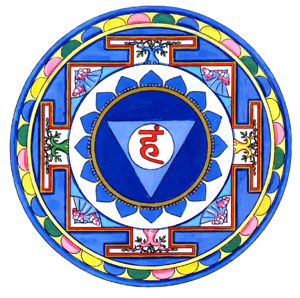First Step to Meditation
Common to the practices of many schools, the first step to meditation is essentially awareness of breathing.
In this presentation, I would like to offer the first level of instruction in the method of meditation that anyone can start and practice any time and anywhere. It is seldom found in books and when suggested in books, it is less frequently properly understood. Yet it is so simple that I have found that even a three-year-old child can take to it.
Steps in the Method
I give here a systematic point-to-point method of starting the practice. Anyone at any age can begin; the younger the better. On the other hand, it is never too late in life to start. Starting even during a terminal illness will be helpful, and may prolong life, or at least it will impart peace. The practice should be done at least once a day, for whatever length of time is available.
It is not in the length of the period of sitting that success lies, but in intensifying the awareness, which comes gradually. One may also practice it at other times of the day, when one is tired and needs a quick recovery of energy, when one gets angry or frustrated and wants to be gentler, when one is busy and is consequently tense and needs to relax so one can be more effective. One may do it waiting at an airport, a railway station, or in a car when someone else is driving. There is no restriction and no limit. No harm can ever come from this practice.
In the Raja Yoga meditation system, as taught by the Himalayan yogis, what follows are the steps of meditation. They constitute the foundation. The reader’s ego may want to say: “I have been practicing meditation for a decade or two, I want something more advanced, I do not need elementary lessons.” This attitude is incorrect.
Many aspirants practice blanking the mind, or holding the breath like an athlete, but they have not learnt the correct method of breathing. In our system, we check everyone on the following points, and only when the foundation has been properly laid do we go any further.
The steps in the method are:
1) Diaphragmatic and uniform breathing.
2) Correct posture, with a straight spine, and no feeling of discomfort in the legs, back or the neck. One should be able to maintain such correct and straight position of the spine without encountering discomfort.
3) Shithili-karana, or systematic relaxation. One should maintain total relaxation of the neuro-muscular system throughout a meditation session.
4) Awareness of breathing. It has some subtler modes that one learns gradually.
5) Using a mantra or a sacred word from whichever spiritual tradition: (a) Initially a sound that flows easily with the breath, such as the word Soham. (b) After such a step has been mastered, a mantra-diksha (initiation into mantra) is given and more advanced methods of refined japa (mental remembrance of the mantra) are gradually introduced.
Let us go into the details of these steps.
Diaphragmatic Breathing
The chief organ controlling the breathing process in our body is the diaphragm, a muscle just underneath the ribs, separating the chest cavity from the abdomen. Ideally, the diaphragm contracts so that we may inhale fully even into the lower lungs. The diaphragm relaxes to push against the lower lungs so that the exhalation from this part of the lungs may be complete. A child at birth breathes diaphragmatically, but later forgets this natural process. One has to re-train oneself to breathe correctly.
In deep and correct breathing, no pressure should be felt in the lungs, and no tension should develop. Breathing should be relaxed so that a feeling of rejuvenation can be experienced.
Diaphragmatic breathing is taught in (a) Makarasana, the crocodile position, lying on one’s stomach, and is practiced further in (b) Shavasana, corpse position, as well as in sitting and standing positions.
To learn the practice, lie on the stomach. Heels slightly apart; tips of the big toes slightly touching; or in whatever way the legs feel relaxed. Cross the right arm over the left and place them in front of you, so that the upper chest is slightly uplifted off the floor. You may then rest the forehead on the forearms near the wrist joints. Keep the neck straight and let the shoulders relax.
Bring your awareness to the breathing process. In this position, it is not possible to do chest breathing. Observe the flow of the breath. Observe the gentle rise and fall of the stomach and the navel area with the smooth flow of the breath.
Let there be no jerks, no breaks in your breathing. Let it flow like a smooth stream. Let it slow down. Observe the gentle flow, along with the rise and fall of the stomach and the navel area. Take note of the breathing process.
Resolve to breathe in this way at all times.
After doing this practice for 5 to 15 minutes, turn over on your back in the shavasana position. Continue to breathe and observe the process of the diaphragm relaxing and contracting (the rise and fall of the stomach and the navel area).
Place your left palm on the chest, right palm on the stomach. No movement should be felt under the left palm; the right palm should feel the rise and fall smoothly, without a jerk, without a break.
Let uniform breathing develop, the length of the inhalation and the exhalation being equal. When this practice has been mastered, one graduates to 2:1 breathing (where exhalation is twice as long as inhalation), but not right now.
When one breathes only diaphragmatically at all times, it is considered that the practice has been mastered.
Correct Posture
It is most important that your spine should be straight for sitting in meditation and ideally at all other times.
Unfortunately, all chairs, sofas, modern beds, seats in cars and aeroplanes are designed to force people to breath incorrectly by making them sit in positions with convoluted spines.
One often sees people sitting in prayer, in kathas and satsangs, with their spines looking sadly like a bent bow. This (a) prevents correct and full breathing, causing short breaths and reducing the life span; (b) generates or worsens many diseases like asthma and heart problems. (c) It also adversely affects the entire neural system whose central flow is in the spine.
A straight spine is not a straight line.
• It is a slightly S-shaped curve:
• convex at the lower-third part (lumbar vertebrae 1 to 5) -concave at the middle-third part (thoracic vertebrae 2 to 12);
• convex at the upper part of the back (cervical vertebrae 5 to thoracic vertebrae 1);
• straight at the neck (cervical vertebrae 1 to 4).
It should be learnt under expert guidance. But a few hints here will be helpful. One need not try to sit in the advanced postures like siddhasana and padmasana, especially if age, physical problems or lack of habit prevents one from doing so. Sitting on a chair or sitting in a comfortable cross-legged position will do quite nicely.
Unfortunately, when people sit in the cross-legged positions, the centre of gravity makes them bend their backs. The answer to that is a simple one.
Fold a blanket and make it into a neat and firm cushion. It is not to serve as your seat, not like a rug to sit on. Place it only under the sit bones, with legs or knees on the floor. This will lift the hips from the ground. Straighten yourself. If there is discomfort anywhere in the back or the neck, you need to experiment with the height of the cushion under the hips; you need to reduce or increase the number of folds in the blanket. Experiment for a few days till you obtain the optimum comfort. Resolve always to sit in this position.
If sitting on the floor is very difficult, you may sit in mitrasana – on the edge of a hard chair, with the feet on the ground. But do sit with the spine straight. Form this habit. Let it become your natural position at all times. You will notice psychological changes in yourself, such as heightened awareness, intentness, self-confidence without unnecessary pride and effectiveness in life.
Having sat in the correct posture, continue breathing diaphragmatically, with mental observation of the flow, and of the gentle rise and fall of the stomach and the navel area, with no feeling of pressure in the chest. If there is tension, the breathing is incorrect.
Systematic Relaxation
Shithili-karana, after diaphragmatic breathing, is the second step practiced in shavasana. There are numerous progressively complex mental exercises done in shavasana, which finally lead to yoga-nidra, and to the entry into the subtle body.
Let us learn here basic methodical relaxation. Lie in shavasana, with feet apart, arms separate from the body, alongside the body, palms up. Continue breathing diaphragmatically. Now, take a mental inventory of your body in the following sequence, asking each part of the body to relax as it is brought to mind.
Forehead, eyebrow, eyes, nostrils, cheeks, jaw and the corners of your mouth, chin, neck, neck joint, shoulders, shoulder joints, upper arms; elbows, lower arms, wrists, hands, fingers, fingertips. Fingertips, hands, wrists, lower arms, elbows, upper arms, shoulder joints, shoulders, chest, heart area, stomach, navel, abdomen, pelvis, thigh joints, thighs, knees, calf muscles, ankles, feet and toes.
Now in the reverse order up the body:
Toes, feet, ankles, calves, knees, thighs, thigh joints, pelvis, abdomen, navel, stomach, heart area, chest, shoulders, shoulder joints, upper arms, elbows, lower arms, wrists, hands, fingers, fingertips. Fingertips, fingers, hands, wrists, lower arms, elbows, upper arms, shoulder joints, shoulders, neck joint, neck, chin, jaw, corners of your mouth, cheeks, nostrils, eyes, eyebrows, forehead.
Remember this sequence. Go over the body in this order; relax each of these parts in this sequence. Let the different parts go limp. For example, the hands should become like the hands of a baby. If you do not succeed in relaxing them at first, or you have been so tense that you have forgotten what it is like for a muscle to be relaxed, you may use a different method of relaxation called tension/relaxation, which is also done in shavasana.
The exact sequence for practicing this relaxation exercise follows. When tensing, tense from the fingers or toes upward. Try to avoid sympathetically tensing muscles other than the ones you are working with. Between segments, pause and relax for 2 breaths. After completing the entire sequence, rest for 10 relaxed breaths.
• Tense and relax the right leg—left leg—right leg—left leg.
• Tense and relax both legs simultaneously. Repeat.
• Tense and relax the right leg and arm—left leg and arm—right leg and arm—left leg and arm.
• Tense and relax the right arm—left arm—right arm—left arm: then both arms simultaneously. Repeat.
• Tense and relax all the limbs simultaneously. Repeat.
After completing either the body sequence relaxation or the tension/relaxation, continue breathing diaphragmatically, with the observation as described before. Lie in this way for a few minutes, then sit up for meditation. Do remember to sit with (a) sit bones on a folded blanket, (b) with the spine straight.
Again, quickly scan the body for any sign of tension that might have developed in the process of changing the position. Relax. Re-establish diaphragmatic breathing.
Breath Awareness
Let your breath flow, smoothly and evenly, with no jerks, no break in the middle of the breath, no break between the breaths, no sound, no gasping. Taila-dharavat, like a smooth stream of oil being poured. Become aware of the flow. No break in the awareness.
Feel the flow and touch of the breath in the nostrils. Continue to do so, without jerk, without interruption. The awareness of inhalation should immediately merge into the awareness of exhalation and vice versa. The awareness of the exhalation is especially important.
If the mind wanders off, because of its usual habit that has been given to it over many lifetimes, straighten your spine again; relax quickly again; re-establish diaphragmatic breathing; continue with the awareness of the flow and touch of the breath in the nostrils.
Mantra or Sacred Word
To begin with, use soham. Some prefer to say hamso and call it the hamsa-mantra. Exhaling, mentally remember the word ham. Inhaling, mentally remember the word so. It means “I am That”. Those in a different religious tradition may use the word prescribed by their tradition, but it should be properly learnt from someone who knows meditation according to that tradition. Those in the Himalayan Tradition are trained to teach according to each person’s religious (or atheist) background.
Let there be no interruptions in breath awareness, nor in the awareness of the flow of the word as a thought. Observe how the breath, the word and the mind are flowing together as a single stream.
Slowly, lengthen the time—not how long you sit—but how many seconds you manage to maintain awareness of the flow of that stream without interruption. Too much effort is self-defeating. One cannot fall asleep by making a determined effort, nor can one enter a meditative state by fighting oneself. Let it flow; let it happen. Don’t do meditation. Observe and experience.
Mantra-diksha
The next step is to seek out someone to give you the first initiation, or mantra-diksha, which is often referred to as a personal mantra. After the mantra initiation, one may be led to methods of meditation individually appropriate for the aspirant. Both a mantra and a meditation mode are assigned according to the individual’s samskaras, imprints in the unconscious gathered over many lifetimes; spiritual needs, and his or her adhikara, level of qualification. There are many different ways of refining the mantra experience through various koshas, sheaths within personality, all the way to final silence. The ajapa state also occurs through the guru’s grace in which the mental remembrance of, listening to, the mantra ceases to be an act and becomes an experience occurring naturally, of its own accord.
One may be taught to proceed on the path of internal sound (nada) or light (jyoti) and to go on the path of the kundalini (a yoga of channeling energies). One may be assigned a particular chakra, center of consciousness, to meditate on from time to time, but the entry into such a meditation occurs only when the initiator mentally touches the disciple’s particular chakra.
In the chakra, one may be assigned a visualization on a certain diagram or other object, or the presence of an ishta devata, one’s favorite or chosen form of the deity, for example Jesus or Mary for Christians, Buddha for the Buddhists, and so on. At this time, the aspirant will also be taught how to merge his mantra with the energy of the given chakra and how to penetrate through its central point (bindu-vedhana). The secrets of these practices are taught in specific Tantras but understood only in the live guru-disciple relationship. The Himalayan Tradition means transmission of consciousness in a direct preceptor-student mutual presence.
Sequential Steps in Learning to Breathe Diaphragmatically
(1) Diaphragmatic Breathing in Crocodile Position
To learn to breathe correctly and to learn to relax by using the correct way of breathing, lie on your stomach, cross your arms, or put one hand on the other, and rest your forehead on the arms, or on the hand; not bending your neck.
Your toes touching, your heels apart, and ankles practically flat on the ground. Your shoulders flat. Your armpits practically touching the ground.
Bring your attention away from all other places and be aware of only the place where you are lying down.
Be aware of only the space that your body is occupying from head to toe.
Now become aware of the flow of your breath. Observe the flow of your breath, as though your breath is flowing through your whole body from top to toes and toes to top.
Breathe gently, slowly, smoothly; no jerk in your breathing; no break in your breathing. Exhale all your tensions and stress; inhale a feeling of fullness, relaxation, peace and purity.
Now bring your attention to the gentle rise and fall of your stomach and the navel area. Observe how that area gently lifts from the ground as you exhale; how it gently touches the ground as you inhale.
Observe that movement with the gentle rhythm of your breathing. This is known as diaphragmatic breathing. No break, no jerks.
Continue to observe the rise and fall of the stomach and navel area, with the gentle rhythm of your breathing; observe which muscles are moving to constitute that movement—and by observing that, learn to breathe correctly, so that you may always breathe in this manner.
You may lie in this position as long as you normally wish.
Continue to breathe in this way, taking note of how the movement occurs along with your breathing.
(2) In Corpse Position
Now, gently roll over and lie on your back with your feet apart, arms separate from the body, along side the body, back of the hand resting on the ground.
Let your entire body relax and again, continue to breathe as you were breathing in the crocodile position.
Observe the gentle rise and fall of the stomach and navel area.
Observe how that area gently relaxes and slightly inflates as you inhale; how it slightly contracts as you exhale.
Place your left palm in the center of your bosom. Place your right palm on your stomach between the sternum and the navel—continue to breathe as before.
Observe that there is no movement under the left palm on the chest. The movement should be felt only under the right palm only.
As you exhale and inhale, gently observe the flow of your breath. No jerks in your breathing; no break.
You may lie in this position, observing the flow of your breath, 10-20 minutes two or three times a day for complete relaxation.
One way to quickly relax your body and your mind is this way we will go through together.
Do this practice for 5 minutes, or less or more than that whenever and wherever is convenient—sitting on a sofa, on an office chair, in a bus, in a car, in a meeting or alone.
Either of the two exercises, or both in sequence, 10-20 minutes two or three times a day, will change the texture and tone of your life in many ways.
Three Minute Relaxation for the Very Busy
Bring your attention only to the place where you are sitting.
Be aware of only the space that your body is occupying from head to toe.
Be aware of only this moment in time.
Very quickly, relax your forehead.
Relax the eyebrows and eyes.
Relax your nostrils.
Relax your cheeks, jaw, and corners of your mouth.
Relax your chin, neck and shoulders.
Relax all the way down to the fingertips.
Relax from your fingertips to your shoulders.
Relax your chest, stomach, navel and abdomen.
Relax your thighs, calves, feet and toes.
Again relax all the organs from the toes upwards and bring your awareness to your breathing.
Observe the gentle rise and fall of your stomach and navel area: how that area gently relaxes as you exhale, how it slightly expands as you inhale.
Observing that, feel the flow and the touch of your breath in your nostrils.
Exhaling, count in your mind ooonnne, inhaling twooo, exhaling threeee, inhaling foouurr, exhaling fiiive; inhaling fiiive, exhaling foouurr, inhaling threeee, exhaling twooo, inhaling ooonnne; continue to count your breaths one through five and five through one. Feel the flow and the touch of your breath in your nostrils, breathing slowly, gently smoothly.
No break in your breathing; no break in your counting, one to five and five to one. Maintain the count.
Feel the flow and the touch of the breath in the nostrils, and continue the practice as long as you wish, and do as frequently as you like.
Without breaking the count, gently open your eyes.
One Minute Meditations with So-ham Mantra
Simply be aware of yourself from head to toe.
Draw around yourself, as it were, three circles of light.
Resolve that the mind shall not cross these three circles, nor will any intruding thoughts and impressions enter from outside.
Remaining aware of yourself from head to toe, in just a few exhalations, relax all your limbs.
Your inhalation is for the purpose of exhalation. So you inhale so that you may be able to exhale.
In each exhalation progressively relax your entire body.
Now resolve that for the next one minute no other thoughts will arise except the awareness of the movement of your stomach and navel area, with the gentle rhythm of your breathing. Maintain that resolve for one minute.
Now resolve that for one minute there will be no other thoughts except the awareness of the path of your breath from the navel to the nostrils, nostrils to the navel; only feel the breath flow on this path. Maintaining the resolve.
Now feel the flow and the touch of your breath in your active nostril; but first resolve that for one minute there will be no intruding thought, only the feel of the flow of the breath in your active nostril.
Now resolve that for one minute there will be no intruding thought except the feel of the breath in your passive nostril.
Resolve that for one minute there will be no other thought except the feel of the breath in your two nostrils.
Now with your breath, exhale thinking the word haaammm, inhaling the word soooo.
Resolve that for the next two minutes there will be no other thought except the feel of the breath in both nostrils, inhaling with soooo, exhaling with haaammm.
Maintain that resolve so that no break occurs between the exhalations and the inhalations.
Resolve for an additional two minutes that as you feel the breath and the word, you observe how the mind and the word are flowing together as a single stream, the mind stream itself becoming the word and the breath; maintaining the resolve for two minutes.
Now eliminate all dualities of the left and the right; come to the sushumna breath. Mentally feel the spot where the nose-bridge ends and the upper lip begins. Mentally feel the spot between the eyebrows.
Inhale as though you were inhaling from the spot in front of the nose-bridge, a subtle energy flowing to the spot between the eyebrows; exhaling the same way.
Maintain the same stream of the mind, word, and the energy flow.
This flow between the two spots is known as sushumna breath.
Resolve that for one minute there will be no other thought only the feel of the flow of the stream in the sushumna channel.
Now using the center between the eyebrows as the gateway, enter the chamber of your mind and resolve for a quarter minute, half a minute, there will be no exterior thought, only the utter silence; as though your mind becomes a lake of silence, absolutely still, without a ripple.
Resolve and maintain the enjoyment of such stillness and silence for a half a minute.
Now from that lake of silence, come again through the gateway between the eyebrows; and resolve for one minute to be only in the sushumna breath.
Maintain the same stream, without the intrusion of any other thought.
Now continue in silence. Only a single ripple arising in the silent stillness of the lake of the mind, and that is the mantra so-ham in the breath.
Every two-three minutes, five minutes, renew the resolve to permit no other exterior thought.
If you have difficulty with that, you may practice the entire process that you have just gone through, in repeated segments and steps described here.
Sit as long as you wish.
Recommended Readings (to be read in the sequence given below):
- Living with the Himalayan Masters by Swami Rama
- Lectures on Yoga by Swami Rama
- Meditation and Its Practice by Swami Rama
- Science of Breath by Swami Rama and others
- A Practical Guide to Holistic Health by Swami Rama
- Superconscious Meditation by Pandit Usharbudh Arya (Swami Veda Bharati)
- Mantra and Meditation by Pandit Usharbudh Arya (Swami Veda Bharati)
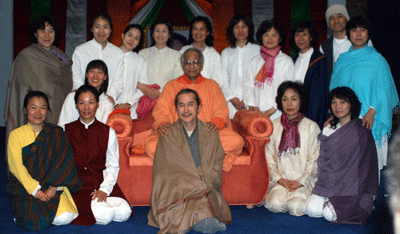
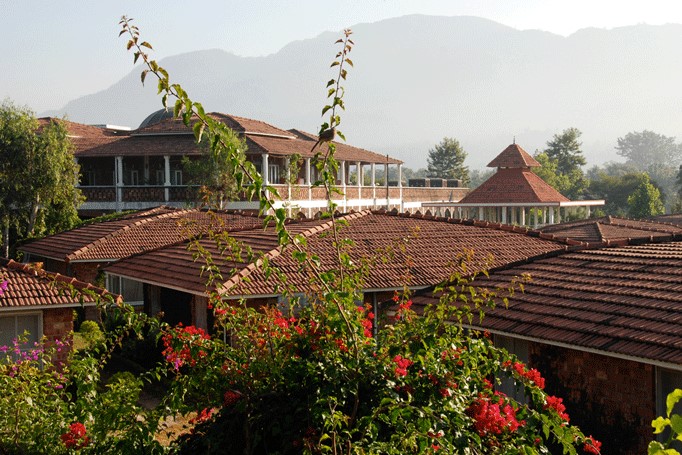
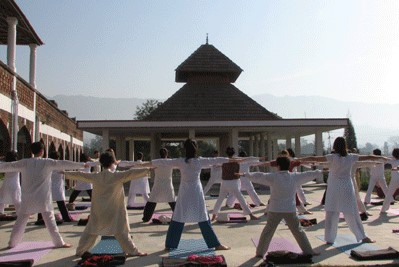 The staff, students and volunteers are all equally warm and positively helpful. There is a certain spirit of commitment. They ensure you are put to comfort, and as in my case, I had a lot of curious questions. I came back convinced and much wiser. Compared to metros, like is slower, but then as a resident told me, they want you to get away from the rush of life.
The staff, students and volunteers are all equally warm and positively helpful. There is a certain spirit of commitment. They ensure you are put to comfort, and as in my case, I had a lot of curious questions. I came back convinced and much wiser. Compared to metros, like is slower, but then as a resident told me, they want you to get away from the rush of life.
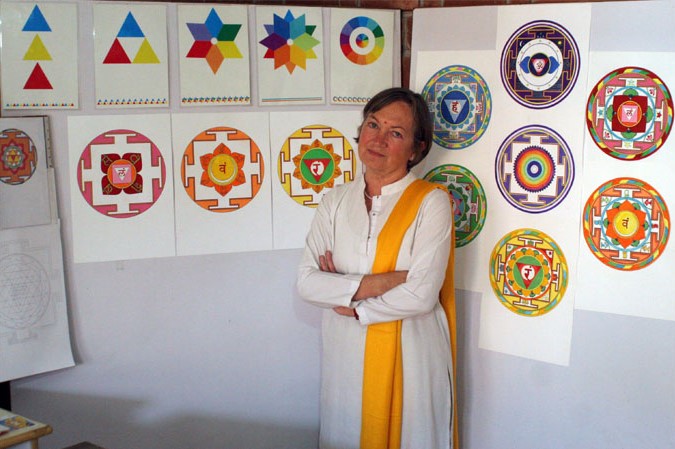
 Cottage 31 was the setting for an inspired workshop this January. Radhika, SRSG Ashram’s sacred art teacher, guided guests and ashramites in the practice of dharana through painting the geometrical forms associated with each chakra.
Cottage 31 was the setting for an inspired workshop this January. Radhika, SRSG Ashram’s sacred art teacher, guided guests and ashramites in the practice of dharana through painting the geometrical forms associated with each chakra.